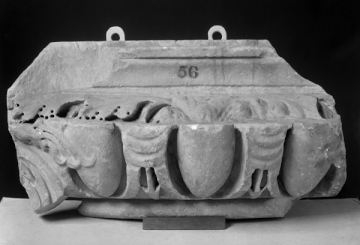Explore Collections


You are here:
CollectionsOnline
/
Fragment of a Roman Composite capital
Browse
Fragment of a Roman Composite capital
Severan (193- 235AD) or slightly later
Luna marble
Height: 29cm
Width: 56cm
Width: 56cm
Museum number: M56
On display: Museum Corridor - outside the Picture Room
All spaces are in No. 13 Lincoln's Inn Fields unless identified as in No. 12, Soane's first house.
For tours https://www.soane.org/your-visit
Curatorial note
This composite capital consists of egg and dart enrichment inserted between the volutes (only a portion at the left) of an Ionic capital; part of the moulded abacus and flat-profiled acanthus enrichment is present above.
This fragment is monumental work of the Severan or slightly later period. The carving is characteristic of a number of Severan buildings and finds a close parallel in the composite capitals preserved in the Baths of Caracalla1 or the capitals of the Arch of Septimus Severus2. The fact that among the quite similar composite capitals from the Forum at Aquileia, one is superior carving in marble3 whereas the ten other examples and a number of fragments are less skilled work in local limestone ("calcare d'Aurisina"4) might lead to the suspicion that a master capital in the best Severan style was sent from Rome and copied by local artists rather than that Aquileia no.775 belongs to construction of the middle of the Second Century. Aquileia nos.78f6, could belong to the later or early post-Severan periods; it seems difficult to place Aquilea no.777 earlier than the end of the previous century, especially when judged by the numerous fine Severan examples of this group in Rome.
G. B. Piranesi illustrates a quite similar arrangement of enrichment in the upper part of a composite capital among the ruins of the so-called sepulchre of Alexander Severus, the Monte del Grano outside the Porta S. Giovanni8 and an example seen in the Farnese gardens on the Palatine9 and therefore from the Severan rebuilding of the Domus Augustana area.
1 Ducati, L'Arte in Roma, pl. CXC, 2; Gusman L'Art decoratif de Rome de la fin de la republique au IV siècle, 2 vols, Paris, 1910, plate 43; Klaus S. Freyberger, Stadtrömische Kapitelle aus der Zeit von Domitian bis Alexander Severus, Zur Arbeitsweise und Organisation stadtrömischer Werkstätten der Kaiserzeit, Mainz, 1990, pp. 113 - 115, cat.no. 270. On reused capitals orm the baths of Caracalla, Giovanna Tedeschi Grisante, Dalle Terme di Caracalla, Capitelle reimpiegati nel Duomo di Pisa, Pisa 1990
2 Freyberger, pp. 108/09, pl. 38a, 41a.
3 Scrinari, Capitelli, no. 77.
4 Loc.cit., p. 59 f., nos. 78 f.
5 Loc.cit., no. 77.
6 Loc.cit., p. 59 f., nos. 78 f.
7 Loc.cit., no. 77.
8 Antichità Romane, II, pl. XXXI. Wilton-Ely, 388
9 De Rom. Mag., pl.XIV. Wilton-Ely, 774
This fragment is monumental work of the Severan or slightly later period. The carving is characteristic of a number of Severan buildings and finds a close parallel in the composite capitals preserved in the Baths of Caracalla1 or the capitals of the Arch of Septimus Severus2. The fact that among the quite similar composite capitals from the Forum at Aquileia, one is superior carving in marble3 whereas the ten other examples and a number of fragments are less skilled work in local limestone ("calcare d'Aurisina"4) might lead to the suspicion that a master capital in the best Severan style was sent from Rome and copied by local artists rather than that Aquileia no.775 belongs to construction of the middle of the Second Century. Aquileia nos.78f6, could belong to the later or early post-Severan periods; it seems difficult to place Aquilea no.777 earlier than the end of the previous century, especially when judged by the numerous fine Severan examples of this group in Rome.
G. B. Piranesi illustrates a quite similar arrangement of enrichment in the upper part of a composite capital among the ruins of the so-called sepulchre of Alexander Severus, the Monte del Grano outside the Porta S. Giovanni8 and an example seen in the Farnese gardens on the Palatine9 and therefore from the Severan rebuilding of the Domus Augustana area.
1 Ducati, L'Arte in Roma, pl. CXC, 2; Gusman L'Art decoratif de Rome de la fin de la republique au IV siècle, 2 vols, Paris, 1910, plate 43; Klaus S. Freyberger, Stadtrömische Kapitelle aus der Zeit von Domitian bis Alexander Severus, Zur Arbeitsweise und Organisation stadtrömischer Werkstätten der Kaiserzeit, Mainz, 1990, pp. 113 - 115, cat.no. 270. On reused capitals orm the baths of Caracalla, Giovanna Tedeschi Grisante, Dalle Terme di Caracalla, Capitelle reimpiegati nel Duomo di Pisa, Pisa 1990
2 Freyberger, pp. 108/09, pl. 38a, 41a.
3 Scrinari, Capitelli, no. 77.
4 Loc.cit., p. 59 f., nos. 78 f.
5 Loc.cit., no. 77.
6 Loc.cit., p. 59 f., nos. 78 f.
7 Loc.cit., no. 77.
8 Antichità Romane, II, pl. XXXI. Wilton-Ely, 388
9 De Rom. Mag., pl.XIV. Wilton-Ely, 774
Rome; collected in Rome by Charles Heathcote Tatham for the architect Henry Holland during the 1790s. See Cornelius Vermeule, unpublished catalogue of the Antiquities at Sir John Soane's Museum, Introduction, transcription of Tatham letters, List 2, no.2.
Literature
Tatham: Drawings, 1.
Associated items
Vol 82/86, watercolour showing this item
Soane collections online is being continually updated. If you wish to find out more or if you have any further information about this object please contact us: worksofart@soane.org.uk


